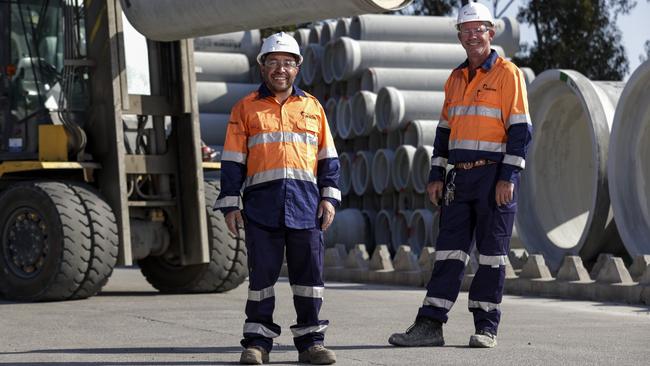What NSW needs to become low carbon manufacturing juggernaut
NSW is perfectly positioned to become a global leader in low carbon heavy manufacturing, but it needs one key thing to make it happen.
New South Wales has the resources, natural assets and skilled workforce to become a global leader in low carbon heavy manufacturing, but the sector needs certainty to fuel demand and drive down costs.
Steel, concrete, glass and other energy intensive building materials will still be needed in a net zero emissions world, and manufacturers say NSW is perfectly positioned to capitalise on the potential economic windfall.
In Western Sydney a number of “first movers” are driving innovation in green construction materials, but these companies need strong signals from government to boost demand, which will increase competition and reduce manufacturing costs.
Green concrete manufacturer Holcim is a market leader in low emissions building materials, with plants and quarries across NSW.
Chief executive George Agriogiannis said the company approached sustainability not just as the “right thing to do morally” but as an income generating “differentiator”.

Holcim builds concrete plants close to where there is construction demand to reduce transport costs and emissions, and Mr Agriogiannis said he was constantly looking for workers.
“Our single biggest challenge at the moment is sourcing people, if people are out there looking for jobs there are plenty out there not just in Western Sydney, right across the country,” he said.
Mr Agriogiannis said governments legislating environmental specifications for new construction tenders would play a “significant role” in accelerating the commercial viability of green concrete and other products.
He welcomed recent increased competition as a sign demand for green concrete products will only increase.
“While we were the first ones stepping into this space in Australia, I couldn’t be happier that others are following,” Mr Agriogiannis said.
Holcim’s sustainability manager Cyril Giraud said by tracking the carbon footprint of its concrete products, the company was able to reduce its emissions, and offset any remaining impact.
“These solutions are not in the future, they exist now and are being used,” he said.
Mr Giraud said the company’s sustainability measures also included targets to minimise freshwater usage and plans to manage the natural environment around quarries.
Australian Industry Group climate and energy lead Tennant Reed said the country had the “great natural resources,” energy capability and skilled people to supply green construction materials globally.
“We should be as good as place as anywhere in the world to do energy intensive, heavy manufacturing,” he said.
The benefits for NSW stretch beyond the factories and plants of Western Sydney, into the regions where communities currently reliant on coal mining for income are perfectly positioned to capitalise on the future needs of manufacturing.
“The Hunter is a terrific place for a greenfield industry,” Mr Reed said.
He said Australia’s manufacturing sector was on track to follow energy generators, who after years of uncertainty now “very clearly see where their role is in a net zero economy”.
“The manufacturing sector is on the same pathway, but a few years behind,” he said.

Mr Reed said while wind and solar had emerged as the cheapest sources of new electricity, there were still a number of different technologies competing to become the most commercially viable options for low carbon steel, concrete, glass and smelting operations.
“There’s a significant cost premium for those options at the moment, which will decrease with deployment and scale,” he said.
“But we’re not far down that path, so the barriers for manufacturers pursuing significant emissions reductions in the medium term are the uncertainty about what the right answer is for them, and the cost gap.”
Mr Reed said hydrogen could “solve a lot of problems of decarbonisation within heavy industry,” but the “biggest problem” at the moment was its high cost.
“You can use hydrogen as part of the steelmaking process instead of coking coal, you can use hydrogen to generate high grade heat for anything from injection moulding plastic to chemical refining to food processing,” he said.
Mr Reed said signals from government were “genuinely important” in driving up demand for low carbon manufacturing, which would allow sectors to scale up.
“If government-owned procurement took emissions reduction into account, they would have even more options at their disposal to increase demand for low, zero and negative emissions products and materials,” he said.
He said updating the building rating systems to incorporate low carbon steel and cement would also be “extremely helpful”.
Western Sydney steel manufacturer Infrabuild, which has committed to becoming carbon neutral by 2030, is another a market-leader looking for opportunities to drive down costs.
The company manufactures new steel from recycled scrap material using electric arc furnaces, which is the lowest carbon emitting, commercially viable steelmaking technology currently available.
Infrabuild chief executive Vik Bansal said he believed the decarbonisation of steel was “here to stay,” but cheaper renewable energy was necessary to make that happen.
“If renewable energy costs in Australia remain prohibitively high, it makes our journey to decarbonise steel very difficult,” he said.
Mr Bansal said one of the biggest challenges for Infrabuild was competing with companies not planning to invest in decarbonisation technologies being imported into Australia.
“Steel products with a higher emission footprint can weaken pricing in the Australian market,” he said.
Mr Bansal said Australia should be “strategic” about ensuring the long term success of domestic manufacturing, and look to examples abroad for how to keep locally produced green steel competitive.
“A well-designed carbon border adjustment would equalise and not penalise domestic or overseas producers,” he said.
For more on this series go to: www.missionzero2050.com.au
Share your feedback or story: missionzero2050@news.com.au
More Coverage
Originally published as What NSW needs to become low carbon manufacturing juggernaut





